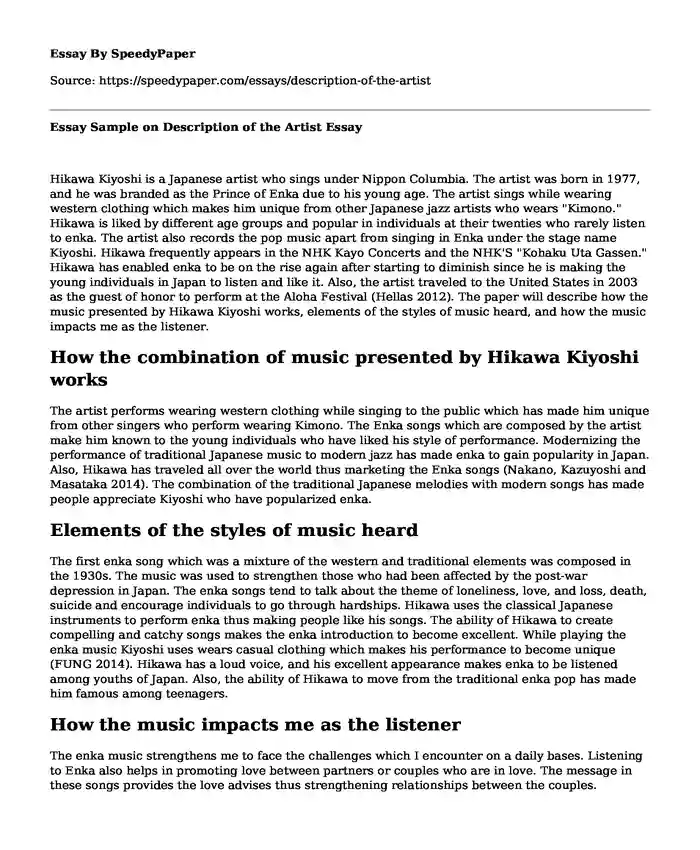Hikawa Kiyoshi is a Japanese artist who sings under Nippon Columbia. The artist was born in 1977, and he was branded as the Prince of Enka due to his young age. The artist sings while wearing western clothing which makes him unique from other Japanese jazz artists who wears "Kimono." Hikawa is liked by different age groups and popular in individuals at their twenties who rarely listen to enka. The artist also records the pop music apart from singing in Enka under the stage name Kiyoshi. Hikawa frequently appears in the NHK Kayo Concerts and the NHK'S "Kohaku Uta Gassen." Hikawa has enabled enka to be on the rise again after starting to diminish since he is making the young individuals in Japan to listen and like it. Also, the artist traveled to the United States in 2003 as the guest of honor to perform at the Aloha Festival (Hellas 2012). The paper will describe how the music presented by Hikawa Kiyoshi works, elements of the styles of music heard, and how the music impacts me as the listener.
How the combination of music presented by Hikawa Kiyoshi works
The artist performs wearing western clothing while singing to the public which has made him unique from other singers who perform wearing Kimono. The Enka songs which are composed by the artist make him known to the young individuals who have liked his style of performance. Modernizing the performance of traditional Japanese music to modern jazz has made enka to gain popularity in Japan. Also, Hikawa has traveled all over the world thus marketing the Enka songs (Nakano, Kazuyoshi and Masataka 2014). The combination of the traditional Japanese melodies with modern songs has made people appreciate Kiyoshi who have popularized enka.
Elements of the styles of music heard
The first enka song which was a mixture of the western and traditional elements was composed in the 1930s. The music was used to strengthen those who had been affected by the post-war depression in Japan. The enka songs tend to talk about the theme of loneliness, love, and loss, death, suicide and encourage individuals to go through hardships. Hikawa uses the classical Japanese instruments to perform enka thus making people like his songs. The ability of Hikawa to create compelling and catchy songs makes the enka introduction to become excellent. While playing the enka music Kiyoshi uses wears casual clothing which makes his performance to become unique (FUNG 2014). Hikawa has a loud voice, and his excellent appearance makes enka to be listened among youths of Japan. Also, the ability of Hikawa to move from the traditional enka pop has made him famous among teenagers.
How the music impacts me as the listener
The enka music strengthens me to face the challenges which I encounter on a daily bases. Listening to Enka also helps in promoting love between partners or couples who are in love. The message in these songs provides the love advises thus strengthening relationships between the couples. Besides, listening to enka songs helps me to relate to various things which happened during the earlier days and those which occur currently in people's lives. Gathering together to listen to the enka artists makes people have unity thus promoting oneness among them (Nakano et al 2014). Listening to these songs helps me to have an interest in trying to find out more about Enka music and other jazz songs which are produced by the Japanese and American jazz artists.
Moments in Enka music and how they move the listener
The scene created by the performance of enka music takes the listeners to an imaginary stage since Hikawa stands alone on the stage without performing the enka moves. Hikawa sings the sad enka music with a lot of emotions and emphasis making the listeners get the message being communicated by the artists (Higgins 111-126). The artist connects particular objects with the lyrics of the song to their emotions and affection. Therefore, these experiences prove to the audience that Hikawa is the prince of Enka.
Work Cited
FUNG, TONG KOON. Enka as a marker of social difference: Uncovering'Tradition'as' Taste'. Diss. 2014. Retrieved from https://scholarbank.nus.edu.sg/handle/10635/53711
Hellas, Gaute. Changes in a Changeless World: Continuity and Discontinuity in Japanese Enka Music. MS thesis. 2012. Retrieved from https://www.duo.uio.no/handle/10852/24216?show=full
Higgins, Shawn M. "Pittsburgh Enka: Jero, Cultural Nationalism, and Japanese Music." The Humanities Review10.1 (2012): 111-126.Retrieved from http://stjenglish.com/wp-content/uploads/8-Higgins.pdf
Nakano, Tomoyasu, Kazuyoshi Yoshii, and Masataka Goto. "Vocal timbre analysis using latent Dirichlet allocation and cross-gender vocal timbre similarity." Acoustics, Speech and Signal Processing (ICASSP), 2014 IEEE International Conference on. IEEE, 2014.Retrieved from https://ieeexplore.ieee.org/abstract/document/6854595/
Cite this page
Essay Sample on Description of the Artist. (2022, Nov 16). Retrieved from https://speedypaper.com/essays/description-of-the-artist
Request Removal
If you are the original author of this essay and no longer wish to have it published on the SpeedyPaper website, please click below to request its removal:
- Free Essay on A Beautiful Mind: A Psychological Theory Perspective
- Free Essay: Would Schools Be Improved if Teachers Were Paid on the Basis of Performance?
- Gross Income: Exclusions, Free Essay on Taxation
- AT & T Compny - Business Strategy and Policy Final. Essay Example
- Characteristics of a Good Ruler, Essay Sample for Your Inspiration
- Essay Sample on Protocols to Manage Nutritional deficiencies
- Essay Sample on Translated Women
Popular categories





